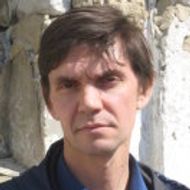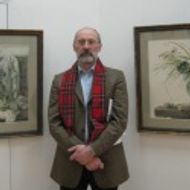- A
- A
- A
- ABC
- ABC
- ABC
- А
- А
- А
- А
- А
- HSE Campus in St. Petersburg
- School of Arts and Humanities
- Department of History
- Seminar "Boundaries of History" Irina Shevelenko "Modernism as Archaism: Nationalism and Search for Modernist Aesthetics in Russia"
-
Department
-
Educational programmes
Address:
190068 Saint Petersburg
123 Griboedov channel, Room 123
Phone:+7 (812)786-92-49
Postal address:
190068 Saint Petersburg
123 Griboedov channel
Seminar "Boundaries of History" Irina Shevelenko "Modernism as Archaism: Nationalism and Search for Modernist Aesthetics in Russia"
On June 1, 2017, the guest of the regular international scientific seminar "The boundaries of history" was Irina Shevelenko who presented a book "Modernism as an Archaism: Nationalism and the Search for the Modernist in Aesthetics in Russia". Book is dedicated to the interpretation of the interaction of searching of Russian modernism and ideas of nation building and interests that are emerging in the community formed in the later imperial period. Much of the research for this book was carried out on the basis of Aleksandr Humboldt’s scholarship in Germany.
The title of the book originated from the initial acquaintance with some random fragments of materials with which work was carried out. Modernism in modern literary criticism is used in different ways, both by philologists and historians. I. Shevelenko emphasizes that he operates this term in a historically narrow and concrete sense: it is a question of historical modernism in the period from the 90's XIX century to the 30’s XX century. From the point of view of the historian, this book is devoted to the epoch of Nicholas II. In particular, to what happened to Russian experimental art against the background of those intellectual movements that were characteristic of the reign of Nicholas. From the point of view of the philologist, I. Shevelenko works with aesthetic facts as with the facts of intellectual history: aesthetics is seen as evidence of certain extra-aesthetic fields, which at this time most clearly manifest themselves, as well as an expression of the great movement of the era, which historians call the word "nationalism". According to Shevelenko, nationalism as a slogan has acquired new tones in use in Europe and Russia after the Second World War. In that era, this point was extremely important: many researchers used the term in a positive, often in a neutral sense. Working with the practice of using words by the figures of that era, Shevelenko emphasizes their importance, since her interest in such evidence of art is due to their reference to the great processes in intellectual history. The author is interested not only in the language in which people thought about art at that time, but also the place of art in large processes. Archaism is used as a convenient term for designating a whole spectrum of phenomena in the aesthetics of Russian modernism, which are associated with appealing to aesthetic models that differ from the models of the 19th century. In the Russian context, archaism referred to those aesthetic patterns that are not related to the Europeanized heritage of imperial culture. To a significant extent, the meeting of modern aesthetics as aesthetics of experimental and archaism as one of the resources of experimental aesthetics takes place at this point. Thus, the research seeks to answer the following questions: why is it that the Russian village is the model for the archaistic trends typical of European modernism, especially for the avant-garde art from the end of the 1900s? Why is the interest of Russian artists, musicians, poets appealing to the legacy of what is conceptualized either as a pre-Petrine culture or as a culture of the lower classes? Thus, archaism is understood as a concept that has culture as a primary referent, constructed, in fact, at the beginning of the 20th century, in which the pre-Petrine culture of elites and peasant modern culture are mixed.
Introduction to the book is accompanied by epigraphs predetermining its content. According to F.I. Buslaev, interest in folklore was perceived as a manifestation of ignorance. However, what Buslaev said in the early 1860s changes radically in the next two decades, which is largely due to the activities of Alexander III, which was accompanied by an attempt to nationalize the empire, the introduction of the Russian style into the architecture and way of life of people. Chekhov's dictum, dating from 1891, underscores the demonstration of interest in the "newly acquired" national aesthetics, which becomes a part of everyday life. Despite this, during the 80's and 90's Russian style turns into an object of ridicule due to its artificiality and deliberateness.
During the revolution of 1905, the archaic people's aesthetics were reappropriated to experimental art as a way of demonstrating their belonging to the state, the empire and, above all, the official Russian style. Russian style as a phrase goes away from the usage of experimental art. After 1905, modernists do not talk about the Russian style; they invented something of their own. A fragment from M.A. Kuzmin's quote demonstrates the statement of serious interest that arose in the educated elite, who had previously been interested in Western art, which reveals itself and the Russian pre-revolutionary culture. There is an interest in using and incorporating folk culture into modern culture through experimental aesthetics.
The figures of experimental art in Russia as a resource for the renewal of aesthetics are turning beyond the borders of their own culture, calling it exotic. Russian modernists, discovering this exotic, conclude that, on the one hand, it does exist, but on the other hand, it turns out to be unreasonable; thus, they try to build a dialogue both for the pre-Petrine culture and for the future, which is the bearer of modern culture. For the project of nationalism, on the one hand, the designation of the roots of Russian culture facilitates the establishment and invention of traditions. On the other hand, modern bearers of this tradition give rise to a new round of reflection on the disunity of Russian society on the educated class and all others, the latter of which turn out to be an important resource of tradition – carriers of that very aesthetics that now need to be revived. In addition, it is necessary to build a national all-estate culture. Consequently, experimental aesthetics becomes a potential field of uniting estates.
One of the main thinkers, who in this period creates a new language for the figures and thinkers of experimental art, was V. Ivanov. A quote from his 1909 article demonstrates a retrospective comprehension of the experience of the 1905 revolution, concluding that the revolution did not win, because there was no unity of the nation. Despite this, there is work by individuals to create a national idea. These are new "dungeon" people who experiment with these processes, understanding that they are the future, and their creation is the platform of a new national idea.
In one of his articles of an earlier period, V. Ivanov, discussing the epoch of small art, singled out its cyclical classification: demotic art is open to the public, but in it the author is detached from his audience. Intimate art, driven by decadents, further leads away from the viewer. Overcoming decadence – modern symbolism – is the art of the cell, which prepares the return of the era of great art, which, in turn, could unite the human collective. Thus, Ivanov launched the idea of the reconstructive potential of experimental art, which could revive the idea of national art.
In another of his articles, Ivanov demonstrated Pan-Slavic interests, pursuing the transformation of the Russian language into the All-Slavic. The novice poet V. Khlebnikov offered his experiences of word making in the "all-Slavic" framework put forward by Ivanov. In 1919, Khlebnikov also stressed this idea when writing his biography. It should be noted that these events occurred against the background of changes in the Slavic movement: in 1908, the Slavic Congress in Prague completely and completely changed the agenda of Slavic cooperation. This new movement will be called "neo-Slavism", which explicitly refuses the idea of unification of Slavs. It is against this background that the idea is not so much of unification as the reconstruction of the language creates a platform for unification that did not take place in the nineteenth century, but which will take place now, as it has a natural cultural basis. Later, a symbolist program is being conceptualized into futurism: in a letter to A. Kruchenykh Ivanov focused on the fact that the artist creates the prerequisites for cardinal changes that directly depend on him – he must do something with the language so that he becomes suitable for the new Future. Quotes testify to the cohesion of nationalism and imperialism. The Russian language turns out to be an empire and makes an evolution in the opposite direction, reconstructing something that never happened, but which should be. Intellectuals tried to reconstruct the archetype, due, rather than return to a certain point in history.
Than, the narrative was dedicated to Diaghilev's enterprise and to the way Diaghilev's Western project is replaced by the project of nationalism. Also to the process of the emergence of the idea of national music, which brings fame to the new Russian art, which is conceptualized by the participants of the enterprise themselves, and by spectators and those who try to comprehend Russianness in art as an introduction in the western Russian culture, the primordial, but forgotten in the XIX century. The theme of authenticity is important until 1910; with the advent of the Russian avant-garde, it goes as a concept from discourse to the background, as it is represented as something inherent in realism, providing a place for the theater and demonstrating the idea of what art can be and how it can unite the audience and actors. These findings are supported by quotations from the diaries of A. Benois, in which the idea of merging the viewer and the actor, which theoretically wrote Ivanov, was embodied.
The plot of the last chapter refers to the beginning of the 1900s to compare official projects in the field of the revival of elements of national culture, in particular, icon painting as a handicraft. On the other hand, the processes taking place against the backdrop of official projects in the 1910s, which were marked by the opening of iconography and the self-proclamation of the avant-garde heirs of true Russian culture, are considered. The opening of iconography coincides with the rise of avant-garde art and allows him to effectively consolidate the right of the discoverer and continuer of the aesthetics that iconography of the 14th-16th centuries represents. At the same time, critics of avant-garde art are beginning to rewrite the history of Russian painting, emphasizing its continuity. Important for this is the fact that the discoveries brought by the icon painting exhibitions transported it from the culture of the lowest to the category of high culture. Based on the above, I. Shevelenko stressed that the tradition of the invention of culture was successful.
At the end of the report, a lively discussion took place, during which N. Ssorin-Chaikov and M. Mogilner drew attention to the use of the term "modernism" in the context of retrospective ideology.
Report was prepared by Margarita Pavlova
-
https://elearning.hse.ru/en/mooc/
Massive Open Online Courses
-
https://www.hse.ru/en/visual/
HSE Site for the Visually Impaired
-
http://5top100.com/
Russian Academic Excellence Project 5-100
- © HSE University 1993–2024 Contacts Copyright Privacy Policy Site Map
- Edit

